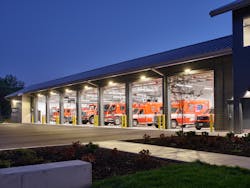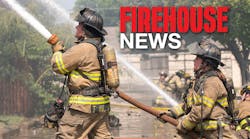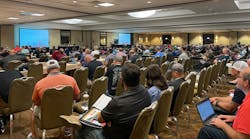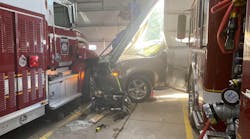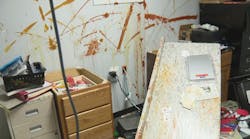The design of essential services and emergency response facilities has long been focused on optimizing first responders’ ability to serve their community. A key, but sometimes overlooked, element of a successful facility is the safety of the responders themselves, and the security of the facilities that house them. Now, more thought is being given on how to protect staff and facilities from outside threats, from vandalism to assault to natural disaster. Fire protection agencies are starting to implement measures to improve safety and mitigate risk. The following are 10 measures to consider for your facility.
1. Dedicated secure parking
Whether it is a career, volunteer or combination facility, opportunities for vandalism and theft can be minimized by separating staff and agency vehicle parking from public parking and publicly accessible areas. Dedicated parking areas for staff are a start, and fenced or walled secure parking areas are even better, providing physical and visual separation from the public.
2. Protection of building infrastructure
Facility infrastructure like emergency generators, fuel storage, transformers and communications equipment are often outside the building enclosure. It is best to locate these items out of public view in a secure portion of the site, which might be within the secure parking area, below grade or in their own protective enclosure. This keeps infrastructure from being tampered with and avoids the possibility of children playing on sensitive or dangerous equipment.
3. Building secure zone
While most facilities want to project a friendly and welcoming atmosphere at the entrance, lobby and reception desk, it is advantageous to create distinct control points with restricted access doors, solid walls and lockable transaction counters. This can be accomplished at the lobby zone, enabling the public to enter the lobby, pick up literature, view antique rigs or historical photographs and gear, access a community room or restrooms, and even speak with someone at a reception desk without entering secure staff-only areas.
4. Community room
Often fire facility training rooms are multi-use, and also serve as community rooms. When developing a dual-purpose training/community room, consider having two means of entry: one off the lobby where the public can enter and a second from the secure portion of the facility. This strategy enables staff to come and go from training without having to circulate through the unsecure portion of the facility. This maintains visual and physical separation of staff from the public.
5. Video monitoring and access control
Digital and/or electronic security measures add a higher level of security and can reduce theft and vandalism. Cameras and electronic locks can serve as an added deterrent against thieves and vandals, and, if the situation arises, provide evidence in the prosecution of suspects.
6. Special needs
Fire stations are frequently co-located with other uses, including training grounds, props for training, and dedicated helipads. NFPA 1402: Standard on Facilities for Fire Training and Associated Props is full of useful information on design considerations and processes. Whether training components include purpose-built training towers, burn buildings, props or an apparatus driving training course, a common theme will be adequate space for the structure, distance from property lines, and physical and visual separation from civilian activity.
Further, the FAA has standards for the design and placement of helipads that should be followed. Beyond FAA and local regulations, designers can reduce the risk by locating the helipad so that the clearances do not require closing roads and stopping traffic.
7. Hardened stations
Although fire stations are thankfully not regularly subjected to attack, it has occurred. An example of this was the 2010 active shooter assault at the McKinney Public Safety Building in Texas, a combined fire and police headquarters facility. Combined police/fire facilities may want to consider hardening the entire facility, and not just the police portions of the building. This should entail vehicle barriers, bullet-resistant glazing and bullet-resistant walls (through paneling or integrated exterior building material, like masonry).
8. Fire protection
While it is possible to build a code-compliant fire station without automatic fire sprinklers, it remains a smart and low-cost strategy for protecting a fire station. However, protection from wildfires may require additional measures, and some of the strategies that NFPA recommends for residential homes should be implemented for fire stations. These include limiting the amount of flammable vegetation, fire-resistant construction, and regular maintenance. A good resource includes the NFPA’s “Preparing homes for wildfires” (nfpa.org/Public-Education/By-topic/Wildfire/Preparing-homes-for-wildfire).
9. Secure outdoor area
Outdoor staff areas are a common feature in modern fire facilities, and provide exposure to fresh air, sunlight and a place to decompress. Whether these are a balcony or a patio or both, areas should be visually screened and physically separated from the public. This allows staff to be able to recharge and be protected without being on display. Consider locating patios on the secure side of the facility, with privacy walls or screening. Similarly, balconies can be screened with a partial height wall rather than open railing.
10. Secure apparatus bay access
Overhead doors are frequently left open to aid in ventilation, cooling or access with the apparatus bay. This reduces security for the staff, equipment, and building. Implementing a means to mitigate having the doors left open will improve security. Consider securing all doors off the apparatus bay by electronic means (electric lock, electric strike, or magnetic lock). This enables staff to gain access to the apparatus bay from secure portions of the building without any restriction, and limits potential unauthorized personnel to the bay itself.
In sum
We have found that carefully considering these measures with our clients can significantly improve facility safety. For optimum and efficient implementation, it is best to bring safety ideas to the table early in the design process. A clear strategy for safety, adopted early on, will result in a facility that better serves both the first responders who work in it, and the community they support.
